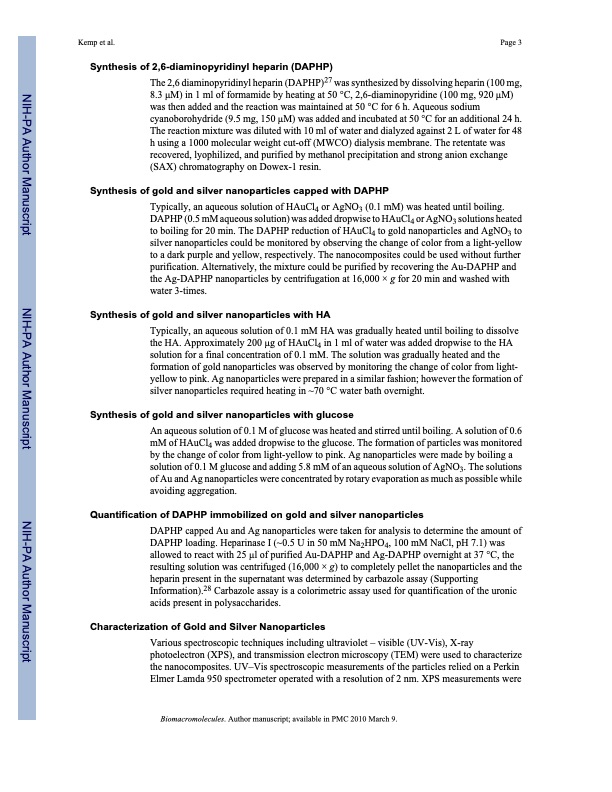
PDF Publication Title:
Text from PDF Page: 003
Kemp et al. Page 3 Synthesis of 2,6-diaminopyridinyl heparin (DAPHP) The 2,6 diaminopyridinyl heparin (DAPHP)27 was synthesized by dissolving heparin (100 mg, 8.3 μM) in 1 ml of formamide by heating at 50 °C, 2,6-diaminopyridine (100 mg, 920 μM) was then added and the reaction was maintained at 50 °C for 6 h. Aqueous sodium cyanoborohydride (9.5 mg, 150 μM) was added and incubated at 50 °C for an additional 24 h. The reaction mixture was diluted with 10 ml of water and dialyzed against 2 L of water for 48 h using a 1000 molecular weight cut-off (MWCO) dialysis membrane. The retentate was recovered, lyophilized, and purified by methanol precipitation and strong anion exchange (SAX) chromatography on Dowex-1 resin. Synthesis of gold and silver nanoparticles capped with DAPHP Typically, an aqueous solution of HAuCl4 or AgNO3 (0.1 mM) was heated until boiling. DAPHP (0.5 mM aqueous solution) was added dropwise to HAuCl4 or AgNO3 solutions heated to boiling for 20 min. The DAPHP reduction of HAuCl4 to gold nanoparticles and AgNO3 to silver nanoparticles could be monitored by observing the change of color from a light-yellow to a dark purple and yellow, respectively. The nanocomposites could be used without further purification. Alternatively, the mixture could be purified by recovering the Au-DAPHP and the Ag-DAPHP nanoparticles by centrifugation at 16,000 × g for 20 min and washed with water 3-times. Synthesis of gold and silver nanoparticles with HA Typically, an aqueous solution of 0.1 mM HA was gradually heated until boiling to dissolve the HA. Approximately 200 μg of HAuCl4 in 1 ml of water was added dropwise to the HA solution for a final concentration of 0.1 mM. The solution was gradually heated and the formation of gold nanoparticles was observed by monitoring the change of color from light- yellow to pink. Ag nanoparticles were prepared in a similar fashion; however the formation of silver nanoparticles required heating in ~70 °C water bath overnight. Synthesis of gold and silver nanoparticles with glucose An aqueous solution of 0.1 M of glucose was heated and stirred until boiling. A solution of 0.6 mM of HAuCl4 was added dropwise to the glucose. The formation of particles was monitored by the change of color from light-yellow to pink. Ag nanoparticles were made by boiling a solution of 0.1 M glucose and adding 5.8 mM of an aqueous solution of AgNO3. The solutions of Au and Ag nanoparticles were concentrated by rotary evaporation as much as possible while avoiding aggregation. Quantification of DAPHP immobilized on gold and silver nanoparticles DAPHP capped Au and Ag nanoparticles were taken for analysis to determine the amount of DAPHP loading. Heparinase I (~0.5 U in 50 mM Na2HPO4, 100 mM NaCl, pH 7.1) was allowed to react with 25 μl of purified Au-DAPHP and Ag-DAPHP overnight at 37 °C, the resulting solution was centrifuged (16,000 × g) to completely pellet the nanoparticles and the heparin present in the supernatant was determined by carbazole assay (Supporting Information).28 Carbazole assay is a colorimetric assay used for quantification of the uronic acids present in polysaccharides. Characterization of Gold and Silver Nanoparticles Various spectroscopic techniques including ultraviolet – visible (UV-Vis), X-ray photoelectron (XPS), and transmission electron microscopy (TEM) were used to characterize the nanocomposites. UV–Vis spectroscopic measurements of the particles relied on a Perkin Elmer Lamda 950 spectrometer operated with a resolution of 2 nm. XPS measurements were Biomacromolecules. Author manuscript; available in PMC 2010 March 9. NIH-PA Author Manuscript NIH-PA Author Manuscript NIH-PA Author ManuscriptPDF Image | Gold and Silver Nanoparticles Stabilized Glycosaminoglycans

PDF Search Title:
Gold and Silver Nanoparticles Stabilized GlycosaminoglycansOriginal File Name Searched:
nihms96339.pdfDIY PDF Search: Google It | Yahoo | Bing
Turbine and System Plans CAD CAM: Special for this month, any plans are $10,000 for complete Cad/Cam blueprints. License is for one build. Try before you buy a production license. More Info
Waste Heat Power Technology: Organic Rankine Cycle uses waste heat to make electricity, shaft horsepower and cooling. More Info
All Turbine and System Products: Infinity Turbine ORD systems, turbine generator sets, build plans and more to use your waste heat from 30C to 100C. More Info
CO2 Phase Change Demonstrator: CO2 goes supercritical at 30 C. This is a experimental platform which you can use to demonstrate phase change with low heat. Includes integration area for small CO2 turbine, static generator, and more. This can also be used for a GTL Gas to Liquids experimental platform. More Info
Introducing the Infinity Turbine Products Infinity Turbine develops and builds systems for making power from waste heat. It also is working on innovative strategies for storing, making, and deploying energy. More Info
Need Strategy? Use our Consulting and analyst services Infinity Turbine LLC is pleased to announce its consulting and analyst services. We have worked in the renewable energy industry as a researcher, developing sales and markets, along with may inventions and innovations. More Info
Made in USA with Global Energy Millennial Web Engine These pages were made with the Global Energy Web PDF Engine using Filemaker (Claris) software.
Infinity Turbine Developing Spinning Disc Reactor SDR or Spinning Disc Reactors reduce processing time for liquid production of Silver Nanoparticles.
| CONTACT TEL: 608-238-6001 Email: greg@infinityturbine.com | RSS | AMP |